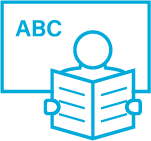Early Cognitive Predictors of PISA Reading in Children with and without Family Risk for Dyslexia

This study examined the language and pre-literacy skills (phonological awareness, rapid naming, and letter knowledge) during pre-school as predictors of PISA reading years later in two groups of children, one group with and one without family-risk for dyslexia. Family risk had an effect on early language and pre-literacy skills, reading fluency, and PISA reading.
Authors: Kenneth Eklund, Minna Torppa, Sari Sulkunen, Pekka Niemi, & Timo Ahonen
Source: Eklund, K., Torppa, M., Sulkunen, S., Niemi, P., & Ahonen, T. (2018). Early Cognitive Predictors of PISA Reading in Children with and without Family Risk for Dyslexia. Learning and Individual Differences, 64, 94–103. DOI: 10.1016/j.lindif.2018.04.012
To identify predictors of Program for International Student Assessment (PISA) reading at age 15, this study examined the language and pre-literacy skills (phonological awareness, rapid naming, and letter knowledge) of two groups of pre-school age children, one group with (n = 88) and one without (n = 70) family-risk for dyslexia. Family risk was found to have a significant effect on early language and pre-literacy skills, reading fluency, and PISA reading. Variance in PISA reading was explained to a good extent by language skills and to a lesser extent by pre-literacy skills.
- A substantial proportion (34%–66%) of children with a family history of dyslexia have severe difficulties with reading and spelling acquisition during their first grades at school.
- For most individuals, these difficulties continue into adolescence—even in transparent orthographies.
- Word recognition and vocabulary are the basic building blocks for reading comprehension.
- Efficient decoding has generally been recognised as necessary for reading comprehension, although a subgroup of poor comprehenders without difficulties in decoding also exists, and at least average text comprehension is also possible for inaccurate or slow decoders.
- Children with family risk for dyslexia are considered a high risk for performing poorly in PISA reading.
- Boys have a higher prevalence of dyslexia than girls.
What is PISA?
- The Organisation for Economic Co-operation and Development (OECD) Program for International Student Assessment (PISA) has been conducted once every three years since 2000. It was to ‘set up to measure how well young adults near the end of compulsory schooling are prepared to meet the challenges of today’s knowledge societies’(OECD, 2002).
- For reading, PISA assesses skills that go beyond decoding and reading comprehension, such as reading literacy.

The study
We examined the extent to which children’s performance in PISA reading could be predicted on the one hand by early language skills, and on the other hand by pre-literacy skills, such as phonological awareness, rapid naming, and letter knowledge through reading fluency at school age. The effect of family risk on these early predictors and reading measures, as well as on their associations, was examined.
Research questions:
- What is the effect of family risk for dyslexia on PISA reading and its predictors when taking into account the effect of gender?
- How well is PISA reading predicted by the two paths leading to reading comprehension: first language skills, and second pre-literacy skills through reading fluency at school-age?
- Does the same predictive model for PISA reading fit with both the family-risk and no-family-risk groups, and are the predictive paths similar for both groups?
All 158 participants were Finnish-speaking and they were followed for ages 2-15 years.The family-risk group (n = 88) consisted of 48% boys and 52% girls, whilst the no-family-risk group (n = 70) consisted of 57% boys and 43% girls.

Findings
- The no-family-risk group outperformed the family-risk group in PISA reading, although the effect-size was small.
- Girls performed better on PISA reading than boys.
- The no-family-risk group outperformed the family-risk group in language skills, phonological awareness, rapid naming, and letter knowledge.
- Girls had better language skills than boys.
- Children in the no-family-risk group read more fluently than children with family risk.
- Cognitive skills and reading fluency were positively associated with PISA reading in both groups, although correlations between PISA reading and early cognitive skills were significantly lower in the no-family-risk group than in the family-risk group.
- Language skills before school-age explained 46% of the variance in PISA reading directly, and indirectly through pre-literary skills and reading fluency by an additional 6%.
- Pre-literacy skills explained 8% of variance in PISA reading through reading fluency.

Implications
- Children with family risk scored significantly lower than children with no family risk in all measures of language and pre-literacy skills before school age, as well as in all measures of reading fluency in grades 1-8, and PISA reading in grade 9.
- A similar model predicting PISA reading fitted the data well in both family-risk and no-family-risk groups.
- Language skills explained a good portion of the variance in PISA reading for both groups.
- Pre-literacy skills explained a significant portion of the variance in PISA reading through reading fluency in both groups, but to a lesser extent than language skills.
- Altogether, 68% of the variance in PISA reading was explained in the family-risk group in contrast to 44% in the no-family-risk group.
- There were salient differences between the family-risk and no family-risk groups in favour of the latter in all cognitive skills assessed before school age.
- The lower skill level and strong associations between the earliest measures (age 2–3.5 years) of language skills, phonological awareness, and letter knowledge to PISA reading in the family-risk group suggests that genetic vulnerability among these children is identifiable at an early stage of development.